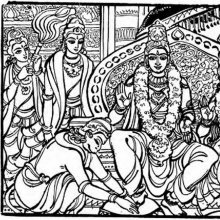Shriramacandra, Śrīrāmacandra, Shri-ramacandra: 2 definitions
Introduction:
Shriramacandra means something in Hinduism, Sanskrit. If you want to know the exact meaning, history, etymology or English translation of this term then check out the descriptions on this page. Add your comment or reference to a book if you want to contribute to this summary article.
The Sanskrit term Śrīrāmacandra can be transliterated into English as Sriramacandra or Shriramacandra, using the IAST transliteration scheme (?).
Alternative spellings of this word include Shriramachandra.
Images (photo gallery)
In Hinduism
Yoga (school of philosophy)
Source: Brill: Śaivism and the Tantric Traditions (yoga)Śrīrāmacandra (श्रीरामचन्द्र) is the name of the teacher of Śivānanda-Sarasvatī, author of the 17th-century Yogacintāmaṇi (a text dealing with Haṭhayoga) consisting of 3423 verses.—Accordingly, “Having bowed to Śrīvyāsa, the ascetic Śaṅkara, the teacher of the world (bhavaguru), [my] teacher Śrīrāmacandra, whose lotus feet are intense bliss, and all of the gods of yogins, the ascetic Śivānanda has written clearly the great Yogacintāmaṇi, which had fallen into an ocean of various texts and has the power to explain everything”.
Source: ORA: Amanaska (king of all yogas): A Critical Edition and Annotated Translation by Jason BirchŚrīrāmacandra (श्रीरामचन्द्र) refers to the “venerable Rāmacandra”, according to the 17th century Yogacintāmaṇi by Śivānanda: a large compilation of roughly 3423 verses dealing with the various methods of (Haṭha) Yoga and Aṣṭāṅgayoga.—Accordingly, “Having bowed to the venerable Vyāsa; the ascetic, Śaṅkara, [who is] the guru of the world; [his own] guru, the venerable Rāmacandra (śrīrāmacandra), whose lotus feet are intense bliss, and all the lords of yoga, the ascetic Śivānanda has written clearly the Yogacintāmaṇi [which] is derived from an ocean of various scriptures and is capable of [conveying] their entire meaning”.

Yoga is originally considered a branch of Hindu philosophy (astika), but both ancient and modern Yoga combine the physical, mental and spiritual. Yoga teaches various physical techniques also known as āsanas (postures), used for various purposes (eg., meditation, contemplation, relaxation).
See also (Relevant definitions)
Partial matches: Shri, Ramacandra.
Full-text (+5): Bharata, Dasharatha, Shitadevi, Hanuman, Anjaneya, Jambavat, Setu, Ciyadatala, Panagadi, Nikhila, Payodhi, Sphuta, Bhagana, Madhyapatita, Nanagrantha, Sandra, Samarthaka, Padambuja, Granthapayodhi, Patita.
Relevant text
Search found 12 books and stories containing Shriramacandra, Śrīrāmacandra, Śrī-rāmacandra, Shri-ramacandra, Sriramacandra, Sri-ramacandra; (plurals include: Shriramacandras, Śrīrāmacandras, rāmacandras, ramacandras, Sriramacandras). You can also click to the full overview containing English textual excerpts. Below are direct links for the most relevant articles:
Ramayana of Valmiki (by Hari Prasad Shastri)
Chapter 30 - Maricha and Suvahu obstruct the sacrifice and are slain by Rama < [Book 1 - Bala-kanda]
Chapter 19 - Shri Ramachandra betrays no sign of distress and prepares for exile < [Book 2 - Ayodhya-kanda]
Chapter 13 - Kaikeyi disregards the king’s immeasurable distress < [Book 2 - Ayodhya-kanda]
Brihad Bhagavatamrita (commentary) (by Śrī Śrīmad Bhaktivedānta Nārāyana Gosvāmī Mahārāja)
Verse 1.4.55 < [Chapter 4 - Bhakta (the devotee)]
Verse 2.4.240 < [Chapter 4 - Vaikuṇṭha (the spiritual world)]
Verse 2.4.254 < [Chapter 4 - Vaikuṇṭha (the spiritual world)]
Srila Gurudeva (The Supreme Treasure) (by Swami Bhaktivedanta Madhava Maharaja)
Sthayi-bhava never changes < [Chapter 1.2 - Śrīla Gurudeva’s Pūrvāśrama]
Taste for Śrīmad-Bhāgavatam < [Chapter 1.2 - Śrīla Gurudeva’s Pūrvāśrama]
Maṭha-sevā < [Chapter 1.4 - Life in the Maṭha]
Chaitanya Bhagavata (by Bhumipati Dāsa)
Verse 1.14.83 < [Chapter 14 - The Lord’s Travel to East Bengal and the Disappearance of Lakṣmīpriyā]
Verse 1.9.54 < [Chapter 9 - Nityānanda’s Childhood Pastimes and Travels to Holy Places]
Verse 1.10.54 < [Chapter 10 - Marriage with Śrī Lakṣmīpriyā]
Shrimad Bhagavad-gita (by Narayana Gosvami)
Verse 1.20 < [Chapter 1 - Sainya-Darśana (Observing the Armies)]
Verse 16.16 < [Chapter 16 - Daivāsura-sampada-yoga]
Verse 17.4 < [Chapter 17 - Śraddhā-traya-vibhāga-yoga]
Sahitya-kaumudi by Baladeva Vidyabhushana (by Gaurapada Dāsa)
Text 7.145 < [Chapter 7 - Literary Faults]
